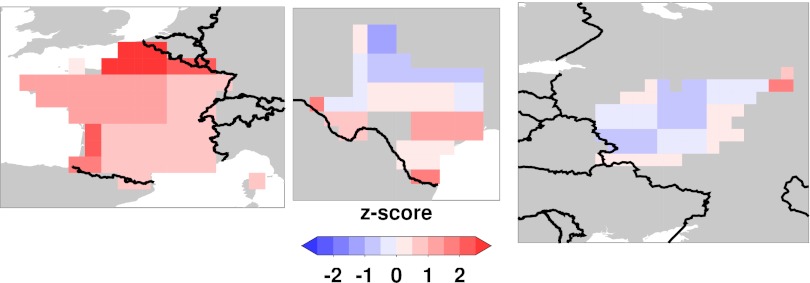In PNAS, Hansen et al. (1) document an observed planet-wide increase in the frequency of extremely hot months and a decrease in the frequency of extremely cold months, consistent with earlier studies (2). This analysis is achieved through aggregation of gridded monthly temperature measurements from all over the planet. Such aggregation is advantageous in achieving statistical sampling power; however, it sacrifices regional specificity. In that light, we find the conclusion of Hansen et al. (1) that “the extreme summer climate anomalies in Texas in 2011, in Moscow in 2010, and in France in 2003 almost certainly would not have occurred in the absence of global warming” to be unsubstantiated by their analysis.
Observations show different areas of the planet warming at different rates, in line with projections from computer models (3). This effect is noticeable in the frequency distributions shown by Hansen et al. (1), in which the spread of the aggregated values increases in recent decades. Hansen et al. also include maps that show the local data feeding their global analysis. Noticeably, Moscow and Texas stand out as areas exhibiting little anomalously warm activity during recent years, barring the single summers of 2010 and 2011, respectively. In contrast, France does appear to be experiencing anomalously warm summers recently.
To quantify local changes in high temperature extremes, we apply extreme value theory methods to the same GISTEMP (Goddard Institute for Space Studies surface temperature analysis) data used by Hansen et al. (1) for the summer months of 1950–2009 (June-July-August in the north and December-January-February in the south) by fitting a time-varying extreme value distribution to the tails of the local frequency distributions (4). A field significance test of our analyses confirms the assertion by Hansen et al. (1) that changes in extreme summer temperatures are globally significant at the P < 0.002 level. Fig. 1 shows z-scores (estimated changes divided by their standard errors) for the differences between the expected 60-y maximum summer mean temperature in the 2009 and 1950 climate states. Results are consistent with Hansen et al. (1). There is no indication of increasingly hot summers near Moscow, and Texas exhibits larger but spatially incoherent changes. On the other hand, France does show large positive changes. Changes near Texas and Moscow are increased if the 2010 and 2011 years are included, but that uses the observation of an event’s occurrence as evidence of its cause; the results for France are insensitive to the inclusion of 2003.
Fig. 1.
The z-scores (estimated changes divided by their SEs) for the differences between the expected 60-y maximum summer mean temperature in the 2009 and 1950 era climate states in France (Left), Texas (Center), and regions surrounding Moscow (Right).
This analysis is far from definitive, lacking, for example, a physically based counterfactual world. We feel that more defensible analyses than presented by either Hansen et al. (1) or us in this letter are necessary to claim causal evidence between individual regional extreme events and anthropogenic changes to the climate system (5).
Footnotes
The authors declare no conflict of interest.
References
- 1.Hansen J, Sato M, Ruedy R. Perception of climate change. Proc Natl Acad Sci USA. 2012;109(37):E2415–E2423. doi: 10.1073/pnas.1205276109. [DOI] [PMC free article] [PubMed] [Google Scholar]
- 2.Seneviratne SI, et al. Changes in climate extremes and their impacts on the natural physical environment. In: Field CB, et al., editors. Managing the Risks of Extreme Events and Disasters to Advance Climate Change Adaptation. Cambridge, UK: Cambridge Univ Press; 2012. pp. 109–230. [Google Scholar]
- 3.Hegerl GC, et al. Understanding and attributing climate change. In: Solomon S, et al., editors. Climate Change 2007: The Physical Science Basis. Contribution of Working Group I to the Fourth Assessment Report of the Intergovernmental Panel on Climate Change. Cambridge, UK: Cambridge Univ Press; 2007. pp. 663–745. [Google Scholar]
- 4.Coles S. An Introduction to Statistical Modeling of Extreme Values. London: Springer; 2001. [Google Scholar]
- 5.Stott PA, et al. Attribution of weather and climate-related events. In: Asrar GR, Hurrell JW, editors. Climate Science for Serving Society: Research, Modelling and Prediction Priorities. Springer; 2013. in press. [Google Scholar]



